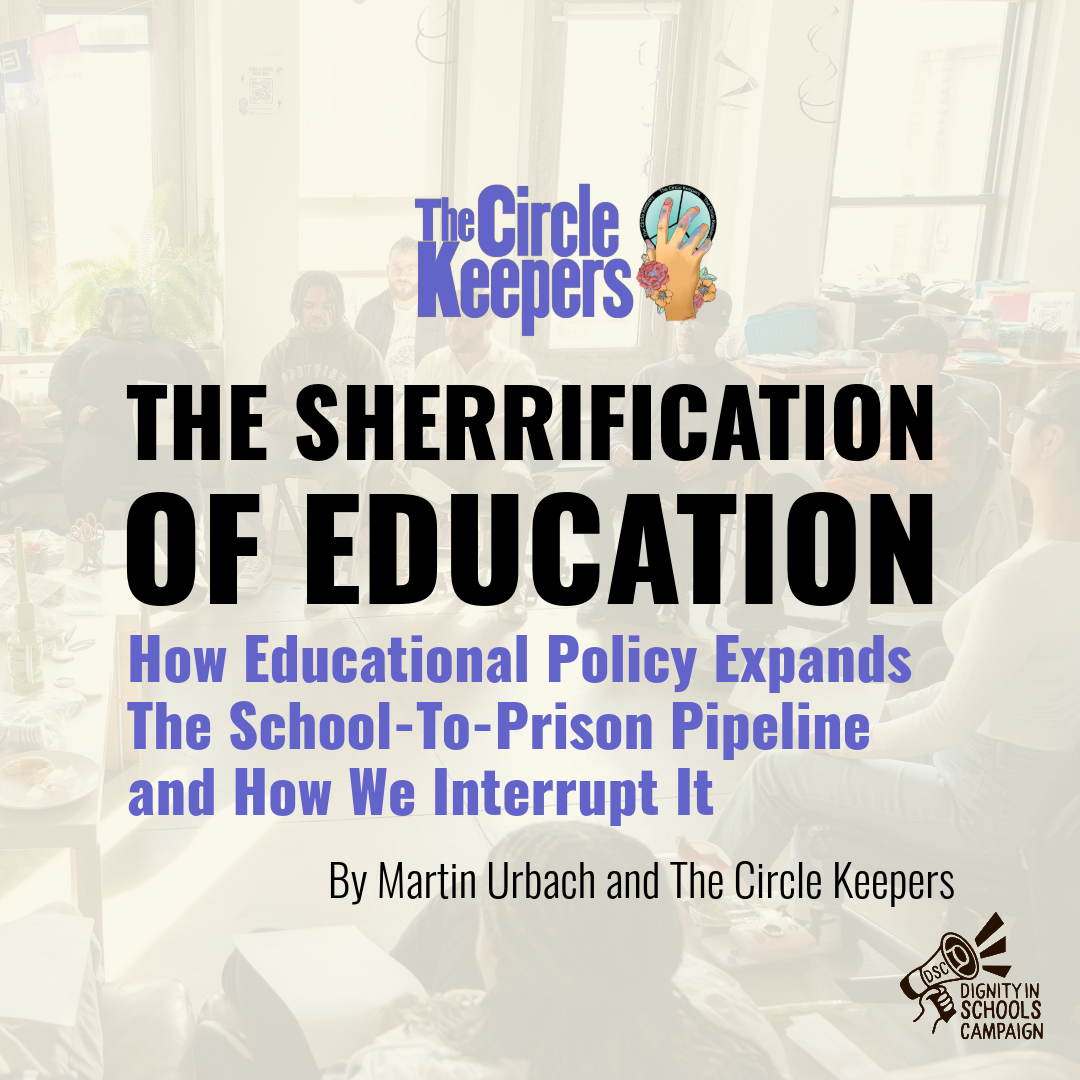The Sherrification of Education; How Educational Policy Expands The School-To-Prison Pipeline and How We Interrupt It.
by Martin Urbach and The Circle Keepers
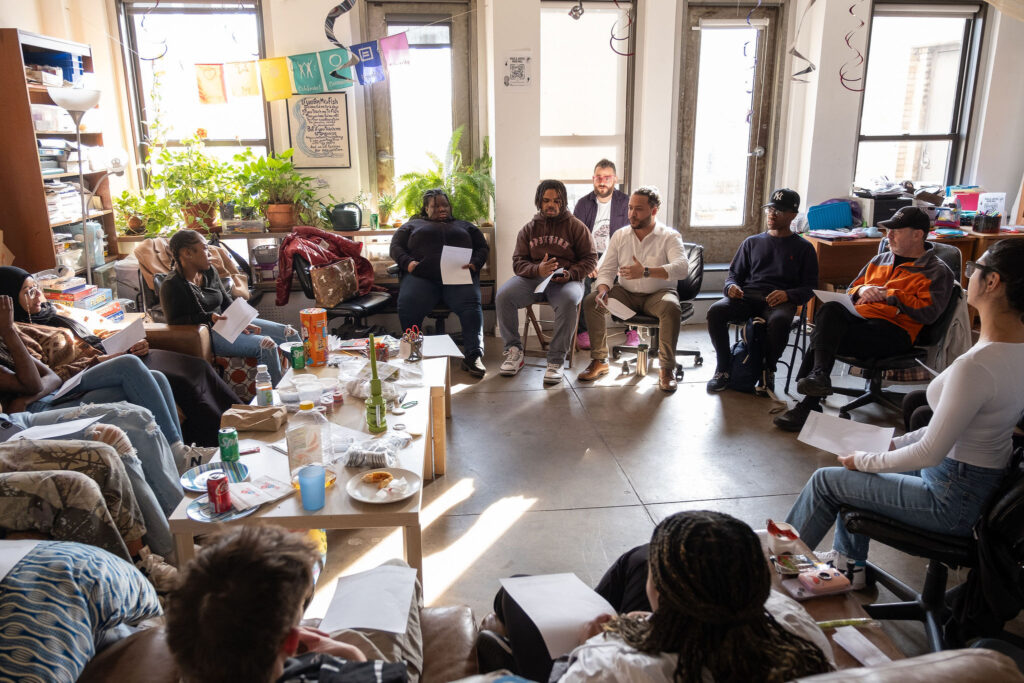
Executive Summary
To this day, the main purpose of the schoolhouse in The United States of America continues to be about the reproduction of model citizens, teaching children to be prompt, obedient, industrious, temperate and subordinate as means to improve the individuals as well as the society and thus; their conditions. As such, all aspects of education -pedagogy, curriculum and policy- work in tandem to uphold, expand and protect the dominant ideologies of those historically in power: middle class, protestant, White males.(Kaestle,1983). Given this history, it is no surprise that school discipline policies persist in ways that are carceral in nature and that permit the particularly aforementioned groups of people to “exercise disproportionate power”, positioning them as “elites” and “reinforcing a cyclical pattern that is difficult to disrupt”. (Jackson, 2013. p233-234)
This policy brief aims to shine a light into the ways in which federal policies such as the Elementary and Secondary Education Act of 1965 along with its multiple renewals; S.2070 The Gun Free Schools Zone Act of 1990, No Child Left Behind (2002), and S.117 Every Student Succeeds Act (2015-2016) have shaped school discipline codes in New York City Public Schools that disproportionately affect Black and Latinx students when compared to their White counterparts. This in turn has helped provide the foundations, as well as the populations, for the school-to-prison pipeline. Borrowing language from scholars Tuck & Yang, I call on the readers to refer to the term “school-to-prison-pipeline” not as a metaphor, but as a phenomenon that takes place in systematic, real time and normalized ways and that has real consequences for Black and Brown students-as well as other groups of minoritized identities that extend beyond the walls of the schoolhouse such as lower graduation rates. These ramifications have significant social effects such as restricting them from access to social opportunities and civil liberties (Scott, Moses, Finnigan,Trujillo & Jackson,2017).
Further, I aim to employ a critical review of the literature including academic articles, policy briefs, and mainstream media pieces to ground the phrase: “The Sherrification of Education” as a way of naming the systematic expansion of police presence and response on school school campuses, aided and abetted by a state sanctioned culture of surveillance and criminalization of Black students and other non White students. I make the case that school discipline codes in the education project in the USA did not develop in a vacuum; but rather were informed by the same racist ideologies and rhetoric that gave birth to the Slave Patrols of the 1700’s all the way through modern day policing including policing initiatives of safety, law & order in New York City such as the NYPD’s “Stop & Frisk”.
Finally, I make the recommendation that schools engage in holistic, wrap-around approaches to create a culture of restorative justice; a “paradigm shift” of sorts (Zher, 1990. p220) that is actively anti-racist transforming our current punitive approaches and responses to harm, which ignore structural racism through “colorblind and power blind mis-implementation models” (Davis, F. as cited in Gregory & Evans, 2020. p13).
Introduction
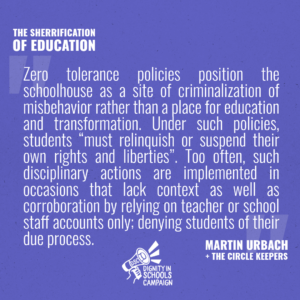
Carl Kaestle’s, 1983 book, Pillars of the Republic asserts that the role of schools was to create the production of model citizens; teaching children to be prompt, obedient, industrious, temperate and subordinate as means to improve the individuals as well as the society and thus; their conditions (p67). The creation of the common schools in the 1800’s was informed by the White, male, protestant and middle class ideologies of the day, which continue to be the dominant ones today.
One of the many ways in which schools today continue to uphold the aforementioned goals is through Zero Tolerance policies. Lawmakers and school officials began implementing Zero Tolerance policies in education via the Gun Free Schools Act of 1994 as a way to keep schools safe from gun violence and other weapons such as knives, following the mass shooting at Columbine High School. Research shows that since then, less than 1% of all infractions nationally are weapons related. (Potter, Boggs, Dunbar, 2017. p80). School officials and lawmakers alike professed that temporary suspensions and or even permanent removals will help them achieve higher standards of discipline and behavior. The reality is that these policies have been used to respond to issues in schools that extend way beyond weapons and that include drugs, alcohol, truancy, tardiness, and “vague catch-all categories such as insubordination and disrespect”, which carry predetermined consequences such as suspension. (Dupper, 2010.p18). This “get tough”, along the “tough on crime” and “3 strikes rules” discourse stems from the equally color blind and race neutral rhetoric to excuse law enforcement policies federally under the war on drugs.
Ironically, punishments that disproportionately affect Black and Brown students such as school suspensions and expulsions were created between 1954-1964, in the ten years leading to the Civil Rights Act, where “public schools were adapting to the Brown V. Board of Ed. Decision” (Scott, Moses, Finnigan, Trujillo,& Jackson, 2017,p12). Once upon a time, no law allowed for suspensions (Jackson, 2013). At the same time that states were mandated to allow children into the schoolhouse, the courthouses were working overtime to legitimize ways to not only kick them right back out, but to continue the narrative of Black children and other children of color, as “unteachable” and dangerous, especially when near white kids. Maisha Winn writes that a “justice seeking movement in schools, insists that no children are throwaways” (Winn, 2018, p.39).
Zero tolerance policies position the schoolhouse as a site of criminalization of misbehavior rather than a place for education and transformation. Under such policies, students “must relinquish or suspend their own rights and liberties” ( Potter, Boggs, Dunbar, 2017. p75). Too often, such disciplinary actions are implemented in occasions that lack context as well as corroboration by relying on teacher or school staff accounts only; denying students of their due process. Furthermore, research shows that school suspensions are ”used increasingly and excessively in schools with majority Black and Latino populations.” (Vavrus & Cole, 2002). Scott, Moses, Finnigan, Trujillo & Jackson (2017) write that “such disproportionate experiences of profiling and punishment in schools set up the conditions for young people of color to experience violence in regularized, systematic, and destructive ways.”
School discipline policies that understand and thus respond to issues of safety only through the eyes of the very same “imperialist white supremacist capitalist patriarchy” (hooks, 1994, p 248) ideologies of the USA, recreate oppressive and violent systems of punishing students of color more harshly than their white counterparts; oftentimes even killing them instead of providing them with support and the education they crave, need and deserve.
Grounded on Kaestle’s account of the role of education as one of subjugating students into obedience, as well as racialized implications of current punitive and carceral school discipline codes such as Zero Tolerance policies, I propose that school discipline policies and modern day policing, both have their origins in the slave patrols of the 1700’s and act as links in the chains of racism in the USA. The schoolhouse is the place where police-ing and policy-ing, work hand in hand to pave and populate the school to prison pipeline with our Black, Latine, queer, Brown, immigrant and working class students and their families.
Born In The USA: The Slave Patrols
“I [patroller’s name], do swear, that I will as searcher for guns, swords, and other weapons among the slaves in my district, faithfully, and as privately as I can, discharge the trust reposed in me as the law directs, to the best of my power. So help me, God.” -North Carolina Slave Patrol Oath
The earliest form of policing in the USA was created in the Carolinas in the 1700’s, to subjugate, terrorize and return runaway slaves to their owners. (NAACP) Policing was created to preserve the slavery system and to protect the economy that White supremacy produces. During Colonial America, the harshest forms of policing were imposed upon slaves as a way to control and subjugate them. They often included beatings, whippings, lynchings and corporal punishment as a means to control enslaved peoples behaviors. Controlling their bodies guaranteed the availability of free forced labor at all times. Controlling their minds- by preventing them from education- was a key strategy to keep slaves docile. Finally, controlling their spirits was instrumental in subduing any hopes of freedom. This uncanny resemblance to the origins of schooling that Kaestle describes in Pillars of The Republic must not be lost on us, the readers.
It is important that we truly understand the correlations between the tactics and procedures used by both police outside schools and police (or deans) inside schools as racialized responses that are informed by racist ideologies and protected by racialized policies. Surveillance for example, has been used to control Black bodies in the name of “safety” since the Antebellum times and throughout the American Revolution. Susan Brown writes of The Book of Negroes; a printed account of runaway notices and identity documents. Lantern laws in colonial New York City, shone a light (pun intended) on Black and Indigenous peoples, who had to carry a candle, or flaming torch when commuting, making them not only visible/surveilled, but easy prey for lynch mobs. (Brown, 2015. p.67) Surveillance of students in schools takes place throughout the day in such interactions ranging from the way students are sitting down, or not sitting down, when, how or why they might be in the hallways, when tending to their physiological needs, as well as when performing their academic duties such as taking tests or even engaging in Socratic seminar. In this context, surveillance occurs hundreds or thousands of times a day, in what Vavrus & Cole (2002, p90) call “disciplinary moments”, which are co-created by all participants, ie: students, teachers and or staff, rather than what a teacher might classify as a disruption, which can and is often tinged through said teachers’ biases. These “disciplinary moments” benefit those on top of the power dynamics; teachers and school staff, and not young people. Most notably, these disciplinary moments, which might have started by what appeared to be a simple and even well-intentioned question such as “where is your bathroom pass?” or “how many times do you need to go drink water?”, function as a tactic of surveillance that often ends up with a suspension or even worse; an arrest or hospitalization.
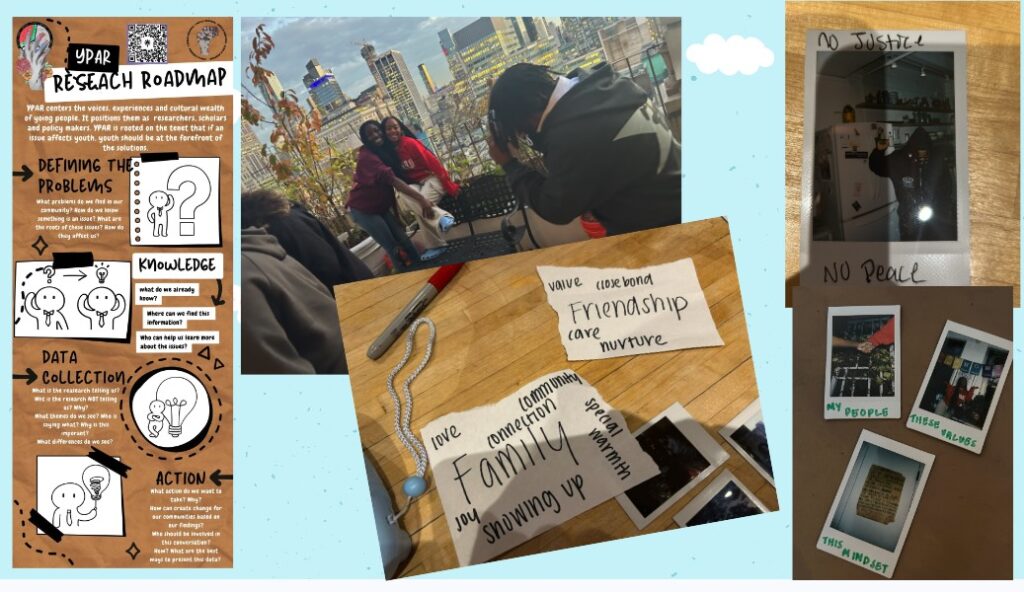 The “Sherrification” of Education
The “Sherrification” of Education
The history of both schooling and policing suggests that thelove affair between them is not by coincidence; it is by design. The two institutions share identical DNA codes and reasons for being: expanding, and protecting racist, capitalist, patriarchal, protestant ideologies in the name of “law and order”. Since their inception, one institution determined who was worthy of education and who was not. The other determines who is guilty or not, and whether or not they deserve death as punishment.
This phenomenon, which I coined “The Sherrification of Education”, names the expansion of police officers, often disguised as school safety officers in school grounds. Additionally, I include policing structures such as metal detectors, holding rooms, and even school code policies such as “lunch detention” in which students are not free to go, and thus detained, or face consequences such as suspensions. The Gun Free Schools Act of 1990 (GFSA) has been perhaps the most instrumental policy in this expansion; positioning police as experts and authorities over teachers on issues of school safety and discipline, not only helping to legitimize their presence but most importantly funding their stay. Rebranded as school resource officers or school safety officers, schools now have cops at every school enforcing a “no excuses” approach through tools like zero tolerance and three strikes laws. This new paradigm has its roots from the Section 4141 of the Elementary and Secondary Education Act of 1965 (ESEA), which in turn gave rise to perhaps the most racist piece of educational policy in American History; The No Child Left Behind (NCLB) Act of 2001 (Public Law 107-110).
The “Zero Tolerance” policies expand the criteria for disciplinary action well beyond weapons, to include behaviors such as insubordination. In addition, the high stakes testing attached to the policies have affected curriculum and functioned as a way to punish communities of color; by dubbing them “failures” and closing their schools, rather than supporting them through equitable funding and undoing historical racial harm.
I am intentional when I say “Sherrification of Education” because I deem paramount to name that police officers in schools are not the only violent people in the room. We educators must face the music and painfully as it might be to admit, most of the time, issues of school discipline that end in violence at the hands of the sheriff, beginning at the hands of the pedagogue. Teachers like me; White, cis and male are the first domino piece that triggers the disproportionate, violent and deadly “colonial era tinged” forms of punishment onto our Black and Brown students. One such is In 2015, former sheriff deputy Ben Fields body slammed and dragged a young Black girl to the floor at a South Carolina high school for insubordination; allegedly refusing to follow a teachers’ orders to go to the schools’ “discipline” office for not turning over her cell phone. The officer told the young woman that if she didn’t go in her own will, he would “make her”. Although the district superintendent said that the district is “deeply concerned” about the confrontation, and that student safety “is and will always be top priority”,a 12-page report found “no probable cause”, thus, Mr. Folds was not charged. (The Associated Press, 2016).
To different degrees, both institutions benefit from laws and policies that shield them from accountability when racist policing occurs, masquerading as school discipline. In education, policies such as Gun Free Schools Act corner school administrators into deploying law enforcement officers if they deem a situation is dangerous enough to grant it. Federal law not only protects the school officials from accountability, much less prosecution, but even encourages the use of police and force if the end goal is law and order. Similarly, police officers such as Mr. Folds are protected and emboldened by the purposely language in the school discipline policies. Anything that any young person says to a police officer can be presented as “insubordination” and thus, creates a free path toward arrest or beat down with impunity. The thin blue line of silence and since even a broken clock is right twice a day, the miniscule number of lawsuits won in police brutality cases are funded with the same taxpayer dollars that policies like the Gun Free Schools Act were supposed to be used to fund the very schools in which cops and teachers alike are brutalizing students instead of teaching them.
Racist Police In The Streets, Racist Policies in The Schools
As an educator teaching in New York City for the past 19 years, I have seen the ways in which Black and Brown youth in New York City have been disproportionately criminalized through such “de jure and/or de facto” policies in schools as well as before and after the school bell rings. When speaking about safety, we must remember that youth do not live separate lives; their school lives and their out-of-school lives are one and the same. Rudy Giuliani adopted The Broken Windows Theory of Policing soon after becoming Mayor in 1993. Broken Windows suggested that “cleaning up the visible signs of disorder — like graffiti, loitering, panhandling and prostitution — would prevent more serious crime as well (NPR,2016). What started as a policing tool to catch fare beaters in the MTA, grew to take over the entire city. In 2001, Mayor Bloomberg’s “Stop & Frisk” practices intensified the ways in which the NYPD racially profiled, harassed, arrested, and now roughed up, once again, using excessive force practices dating from the Slave Patrols to anyone who fit the narrative of its rhetoric; Black people, immigrants, people with disabilities.
In the Alliance For Quality Education’s groundbreaking June 2019 report, Systemic Racism & New York State’s School To Prison Pipeline, data demonstrates an increasing scale of cruelty from school to law enforcement to juvenile detention, starting with educators who escalate solvable conflicts by referring youth to law enforcement. For example, in 2019, Black children comprised only 25% percent of all youth in New York City, yet 65% of the youth detained in juvenile detention facilities were Black, followed up by 28% Latinx youth and only 3% White youth. Despite being part of a minority population, our youth of color are being policed at a rate astronomically higher than their peers.
Racist Rhetoric, Racist Media & Racist Propaganda
Case in point, attorney Olayemi Olurin’s 3/29/24 appearance on The Breakfast Show, questioning Mayor Eric Adams fear-mongering rhetoric of NYC being both a “dangerous city”- to excuse the millions of dollars of funding toward more policing in NYC Subways and even deploying the national guard- while at the same time stating the NYC is one of the safest cities in The USA. This rhetoric has had devastating implications for students of color abilities to succeed in school. Their over representation in the media as “criminals”, “super predators” and “rapists”, makes it easier for them to be racially targeted, punished and even criminally charged in schools by police. The realities and consequences of this, is what we call The School to Prison Pipeline. (Kim, ___).
It is imperative to keep in mind that the clear majority of youth of color that get criminalized are found innocent (NYCLU, 2016, Vera Institute,2016). Although in recent years the New York City Department of Education, now NYC Public Schools has changed toward more progressive stances like restorative justice practices, the infractions defined under “Zero Tolerance” remain the basis for what is considered “unsafe behavior” in schools today. These range from bringing weapons, alcohol or drugs to schools, to bringing nail clippers, aspirin or hats. These also include behaviors such as fighting, threatening or insubordination, which when described out of context and narrated by the White people in power, can be positioned to uphold and advance the rhetoric of “criminals” when describing people of color.
Recommendations
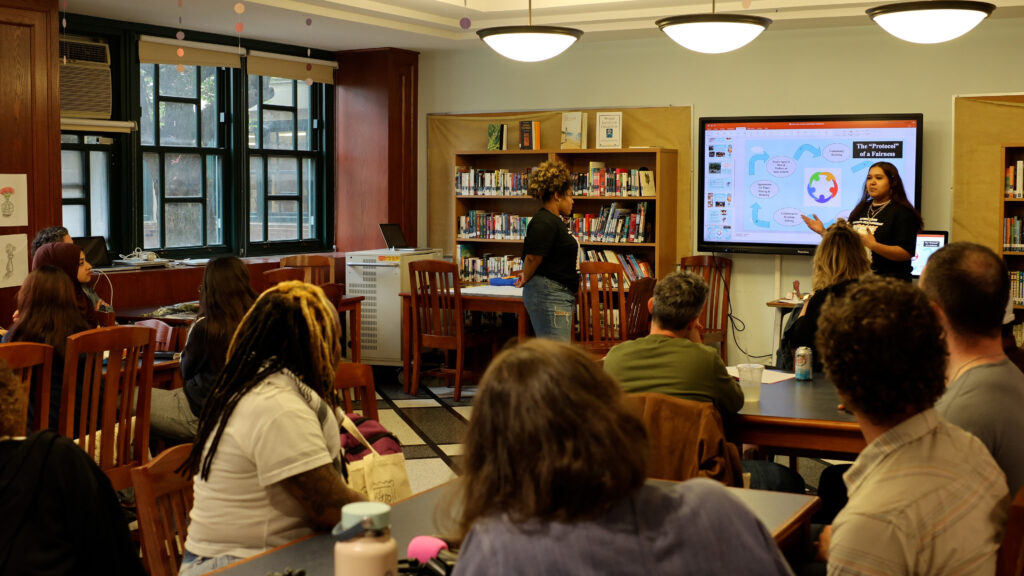
Restorative Justice rather than being a set of school discipline interventions or even policies is a “paradigm shift” of sorts (Zher, 1990. p220) reframing how we live in community with one another, what we value and how we collectively address and respond to conflict, harm and violence. Restorative justice tenets such as accountability, engagement, dignity, voice, agency and restoration, among others can and must become keywords when thinking of ways of addressing interpersonal harm in schools. Restorative Justice is grounded on indigenous and Black ontologies; ways of being ands also epistemologies; ways of knowing such as knowledge of elders, respect for all living things, and caring for the most vulnerable, where all community members come together to find solutions to issues that affect them, centering peacemaking through rituals such as circles.
Although in the USA, restorative justice has mostly been used in the judicial system as a response to crime and wrongdoing, there is accumulating and promising evidence that restorative justice practices can diminish the use of exclusionary discipline such as suspensions or expulsions (Fronius, Darling-Hammond, Persson, Guckenburg, Hurley, & Petrosino. 2019) Thus, we make the following five recommendations as antidotes to transform the harm that “The Sherrification of Education”; the punitive justice based system of school discipline that overly relies on police and policing which we currently have.
Fully funding comprehensive,holistic, anti racist, healing centered, trauma informed restorative justice programs in schools. This includes staffing a full time restorative justice team with coordinators, practitioners, social workers, teachers and youth, who are trained and who have meaningful opportunities to collaborate in developing and sustaining such a program. RJ programs in schools must equal parts support students socially, emotionally and academically.
Emphasize the need to focus on restorative justice education embedded in the day-to-day culture of the school. RJ needs to be present in the curriculum by way of courses offered when possible, as well as embedded in the advisory/crew curriculum for students as well as meaningful, ongoing professional development for staff.
Create strategic short term and long term goals for implementation and policy shifts. Since RJ in school is a fairly new endeavor and we recognize the messiness of responding to conflict in school based settings with youth and adults alike, it is imperative that schools aiming to implement RJ develop policies, commit to a timeline of 3-5 years minimally to focus on fidelity of implementation.
Invest in long term, mixed methods research projects. The implementation plan should be malleable, and evolve based on data collected by the RJ team as well as all stakeholders. Schools should center plans and procedures that will work for them as a community, rather than adopt step-by-step guidebooks, where they can check boxes that might not apply.
Fully commit to interrupt the school to prison pipeline. RJ programs need to explicitly identify, interrupt and abolish racism, classism, sexism, ableism, homophobia, transphobia, misogyny, xenophobia, White supremacy, militarism, imperialism, capitalism, among others as systems and structures, rather than solely focusing on conflict resolution mediations.
The aforementioned recommendations are not an end point, but rather a beginning. They are meant to work together, in tandem with one another as a means to develop a shift in culture away from sheriffs who stand in formation and toward healers who share information.
REFERENCES
Browne, S. (2015). Dark matters : on the surveillance of blackness. Duke University Press.
Dupper, D. R. (2010). A new model of school discipline: Engaging students preventing behavioral problems. New York, NY: Oxford University Press.
Fronius, T., Darling-Hammond, S., Persson, H., Guckenburg, S., Hurley, N., & Petrosino, A. (2019). Restorative justice in U.S. schools: An updated research review. Retrieved December 3, 2019, from https://www.wested.org/wp-content/uploads/2019/04/resource-restorative-justicein-u-s-schools-an-updated-research-review.pdf
Gregory, A., & Evans, K.R. (2020). The Starts and Stumbles of Restorative Justice in Education: Where Do We Go from Here? Boulder, CO: National Education Policy Center. Retrieved [date] from http://nepc.colorado.edu/publication/restorative-justice.
Hummel, Jeffrey Rogers (July 2002). “Review of Sally E. Hadden – Slave Patrols: Law and Violence in Virginia and the Carolinas.”Economic History Services
Jackson, Darrell, Teaching Tomorrow’s Citizens: The Law’s Role in Educational Disproportionality (2013). Alabama Civil Rights & Civil Liberties Law Review, Vol. 5, No. 2, 2013, Available at SSRN: https://ssrn.com/abstract=3690602
Kim, C. Y., Losen, D. J., Hewitt, D. T. (2012). The School-to-Prison Pipeline: Structuring Legal Reform. United States: NYU Press.
NBCUniversal News Group. (2015, October 27). Video shows cop body-slamming high school girl in S.C. classroom. NBCNews.com. http://www.nbcnews.com/news/us-news/video-appears-showcop-body-slamming-student-s-c-classroom-n451896
Origins of Police History. [retrieved from] https://time.com/4779112/police-history-origins/
Press, T. A. (2016, September 3). Deputy who tossed a S.C. High School student won’t be charged (published 2016). The New York Times. https://www.nytimes.com/2016/09/03/afternoonupdate/deputy-who-tossed-a-sc-high-school-student-wont-be-charged.html
Potter, H., Boggs, B., & Dunbar, C. (2017). Discipline and punishment: How schools are building the school-to-prison pipeline. In Advances in Race and Ethnicity in Education (pp. 65-90). (Advances in Race and Ethnicity in Education; Vol. 4). Emerald Group Publishing Ltd.. https://doi.org/10.1108/S2051-231720160000004005
Scott, J., Moses, M.S., Finnigan, K.S., Trujillo, T., & Jackson, D.D. (2017). Law and Order in School and Society: How Discipline and Policing Policies Harm Students of Color, and What We Can Do About It. Boulder, CO: National Education Policy Center. Retrieved [date] from http://nepc. colorado.edu/publication/law-and-order
Stelloh, T. & Connor, T. (2015, October). Video shows cop body-slamming high school girl in S.C. classroom. Retrieved April 20, 2017, from NBC News, https://www.archives.gov/milestone-documents/brown-v-board-of-education#:~:text=In%20this%20milestone%20decision%2C%20the,1896%20Plessy%20v.%20Ferguson%20case.
Stop-and-Frisk Data”. New York Civil Liberties Union. January 2, 2012. Retrieved November 30, 2019.
Text – S.2070 – 101st Congress (1989-1990): Gun-Free School Zones Act of 1990 | congress.gov | library of Congress. (n.d.). https://www.congress.gov/bill/101st-congress/senate-bill/2070/text
S.1177 – 114th Congress (2015-2016): Every student succeeds act | congress.gov | library of Congress. (n.d.-a). https://www.congress.gov/bill/114th-congress/senate-bill/1177
The origins of modern day policing. NAACP. (2021, December 3). https://naacp.org/find-resources/history-explained/origins-modern-day-policing
Vavrus, F., Cole, K. “I Didn’t Do Nothin’”: The Discursive Construction of School Suspension. The Urban Review 34, 87–111 (2002). https://doi.org/10.1023/A:1015375215801
Winn, M.T. (2018). Justice on both sides. Transforming education through restorative justice. Cambridge, MA: Harvard Education Press.
Davis, F. (2019). The little book of race and restorative justice. New York, NY: Good Books.
Kaestle, Carl, and Foner, Eric. 1983. Pillars of the Republic: Common Schools and American Society,1780–1860 (1st ed., American Century Series). New York: Hill and Wang.
YouTube. (2024, March 29). Olay crushes Conservative NYC mayor Eric Adams in wild debate. YouTube. https://www.youtube.com/watch?v=J_wD-vPh8gs
79 stat. ] public law 89-253-oct. 9, 1965 973 … (n.d.-a). https://www.congress.gov/89/statute/STATUTE-79/STATUTE-79-Pg973.pdf

